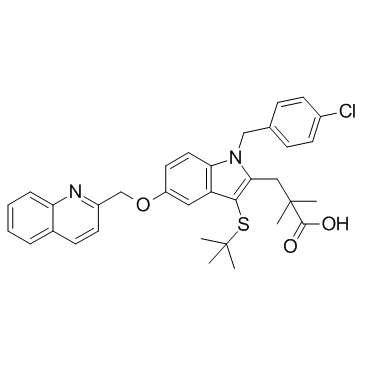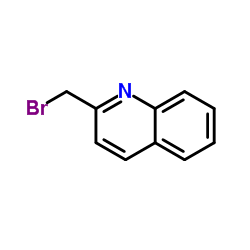喹夫拉朋

喹夫拉朋结构式

|
常用名 | 喹夫拉朋 | 英文名 | MK-0591 |
|---|---|---|---|---|
| CAS号 | 136668-42-3 | 分子量 | 587.171 | |
| 密度 | 1.2±0.1 g/cm3 | 沸点 | 751.3±60.0 °C at 760 mmHg | |
| 分子式 | C34H35ClN2O3S | 熔点 | N/A | |
| MSDS | N/A | 闪点 | 408.2±32.9 °C |
喹夫拉朋用途MK591 (free acid) 是FLAP特异性抑制剂,IC50 为1.6 nM。 |
| 中文名 | 喹夫拉朋 |
|---|---|
| 英文名 | 3-[3-tert-butylsulfanyl-1-[(4-chlorophenyl)methyl]-5-(quinolin-2-ylmethoxy)indol-2-yl]-2,2-dimethylpropanoic acid |
| 中文别名 | 1-[(4-氯苯基)甲基]-3-[(1,1-二甲基乙基)硫代]-α,α-二甲基-5-(2-喹啉甲氧基)-1H-吲哚-2-丙酸 |
| 英文别名 | 更多 |
| 描述 | MK591 (free acid) 是FLAP特异性抑制剂,IC50 为1.6 nM。 |
|---|---|
| 相关类别 | |
| 靶点 |
IC50 value: 1.6 nM (FLAP)[1]. |
| 体外研究 | MK591(游离酸)是完整的人和引发的大鼠多形核白细胞(PMNL)(分别为IC50值3.1和6.1 nM)以及人类,松鼠猴和大鼠全血中白三烯(LT)生物合成的有效抑制剂(IC50值)分别为510,69和9nM)。 MK591(游离酸)对大鼠5-脂氧合酶没有影响。 MK591(游离酸)对5-脂氧合酶活化蛋白(FLAP)具有高亲和力,如FLAP结合测定中IC50值1.6nM和两种不同光亲和配体对FLAP的光亲和标记的抑制所证明。通过抑制人类PMNL中酶从细胞质转移到膜上,显示出对5-脂氧合酶活化的抑制[1]。 |
| 体内研究 | MK591(游离酸)是体内LT生物合成的有效抑制剂,首先,在体外攻击从经处理的大鼠和松鼠猴获得的血液后,其次是在大鼠胸膜炎模型中,第三,通过抑制尿液监测在抗原攻击的过敏性绵羊中排泄LTE4。在用甲基麦角酰胺,蛔虫攻击的松鼠猴和蛔虫攻击的绵羊(早期和晚期反应)预处理的近交系大鼠中观察到MK591(游离酸)对抗原诱导的支气管收缩的抑制[1]。每天皮下注射载体或MK591(游离酸)10,20或40mg/kg皮下注射第1-4,5-9或10-14天。在第14天,对肺进行充气,固定和染色以进行组织病理学和形态学分析。用MK-0591(游离酸)未处理的高氧组治疗的高氧组显示出异常肺泡化的明确证据,但没有炎症[2]。 |
| 参考文献 |
| 密度 | 1.2±0.1 g/cm3 |
|---|---|
| 沸点 | 751.3±60.0 °C at 760 mmHg |
| 分子式 | C34H35ClN2O3S |
| 分子量 | 587.171 |
| 闪点 | 408.2±32.9 °C |
| 精确质量 | 586.205688 |
| PSA | 89.65000 |
| LogP | 8.31 |
| 蒸汽压 | 0.0±2.6 mmHg at 25°C |
| 折射率 | 1.617 |
| 储存条件 | 2-8℃ |
|
~% 
喹夫拉朋 136668-42-3 |
| 文献:Merck Frosst Canada, Inc. Patent: US5254541 A1, 1993 ; Title/Abstract Full Text Show Details Merck Frosst Canada, Inc. Patent: US5254567 A1, 1993 ; |
|
~% 
喹夫拉朋 136668-42-3 |
| 文献:Frenette, Richard; Hutchinson, John H.; Leger, Serge; Therien, Michel; Brideau, Christine; Chan, Chi C.; Charleson, Stella; Ethier, Diane; Guay, Jocelyne; Jones, Tom R.; McAuliffe, Malia; Piechuta, Hanna; Riendeau, Denis; Tagari, Philip; Girard, Yves Bioorganic and Medicinal Chemistry Letters, 1999 , vol. 9, # 16 p. 2391 - 2396 |
|
~% 
喹夫拉朋 136668-42-3 |
| 文献:Frenette, Richard; Hutchinson, John H.; Leger, Serge; Therien, Michel; Brideau, Christine; Chan, Chi C.; Charleson, Stella; Ethier, Diane; Guay, Jocelyne; Jones, Tom R.; McAuliffe, Malia; Piechuta, Hanna; Riendeau, Denis; Tagari, Philip; Girard, Yves Bioorganic and Medicinal Chemistry Letters, 1999 , vol. 9, # 16 p. 2391 - 2396 |
|
~% 
喹夫拉朋 136668-42-3 |
| 文献:Frenette, Richard; Hutchinson, John H.; Leger, Serge; Therien, Michel; Brideau, Christine; Chan, Chi C.; Charleson, Stella; Ethier, Diane; Guay, Jocelyne; Jones, Tom R.; McAuliffe, Malia; Piechuta, Hanna; Riendeau, Denis; Tagari, Philip; Girard, Yves Bioorganic and Medicinal Chemistry Letters, 1999 , vol. 9, # 16 p. 2391 - 2396 |
| 1H-Indole-2-propanoic acid, 1-[(4-chlorophenyl)methyl]-3-[(1,1-dimethylethyl)thio]-α,α-dimethyl-5-(2-quinolinylmethoxy)- |
| quiflapon |
| 3-[1-[(4-chlorophenyl)methyl]-5-(quinolin-2-ylmethoxy)-3-tert-butylsulfanyl-indol-2-yl]-2,2-dimethyl-propanoic acid |
| 3-[3-(tert-Butylsulfanyl)-1-(4-chlorobenzyl)-5-(quinolin-2-ylmethoxy)-1H-indol-2-yl]-2,2-dimethylpropanoic acid |
| 3-[3-(1,1-dimethylethylthio)-5-(quinolin-2-ylmethoxy)-1-(4-chlorophenylmethyl)indol-2-yl]-2,2-methylpropionic acid |
| 3-[3-(1,1-dimethylethylthio)-5-(quinolin-2-ylmethoxy)-1-(4-chlorophenylmethyl)indol-2-yl]-2,2-dimethylpropionic acid |
| 3-[1-(4-Chlorobenzyl)-3-[(2-methyl-2-propanyl)sulfanyl]-5-(2-quinolinylmethoxy)-1H-indol-2-yl]-2,2-dimethylpropanoic acid |
| Quiflapon [INN] |
| 1-((4-Chlorophenyl)methyl)-3-((1,1-dimethylethyl)thio)-a,a-dimethyl-5-(2-quinolinylmethoxy)-1H-indole-2-propanoic Acid |
| 3-[N-(p-chlorobenzyl)-3-(t-butylthio)-5-(quinolin-2-ylmethoxy)indol-2-yl]-2,2-dimethylpropanoic acid |
| MK 0591 |
| 3-(tert-Butylthio)-1-(p-chlorobenzyl)-a,a-dimethyl-5-(2-quinolylmethoxy)indole-2-propionic Acid |
| MK-0591 |






